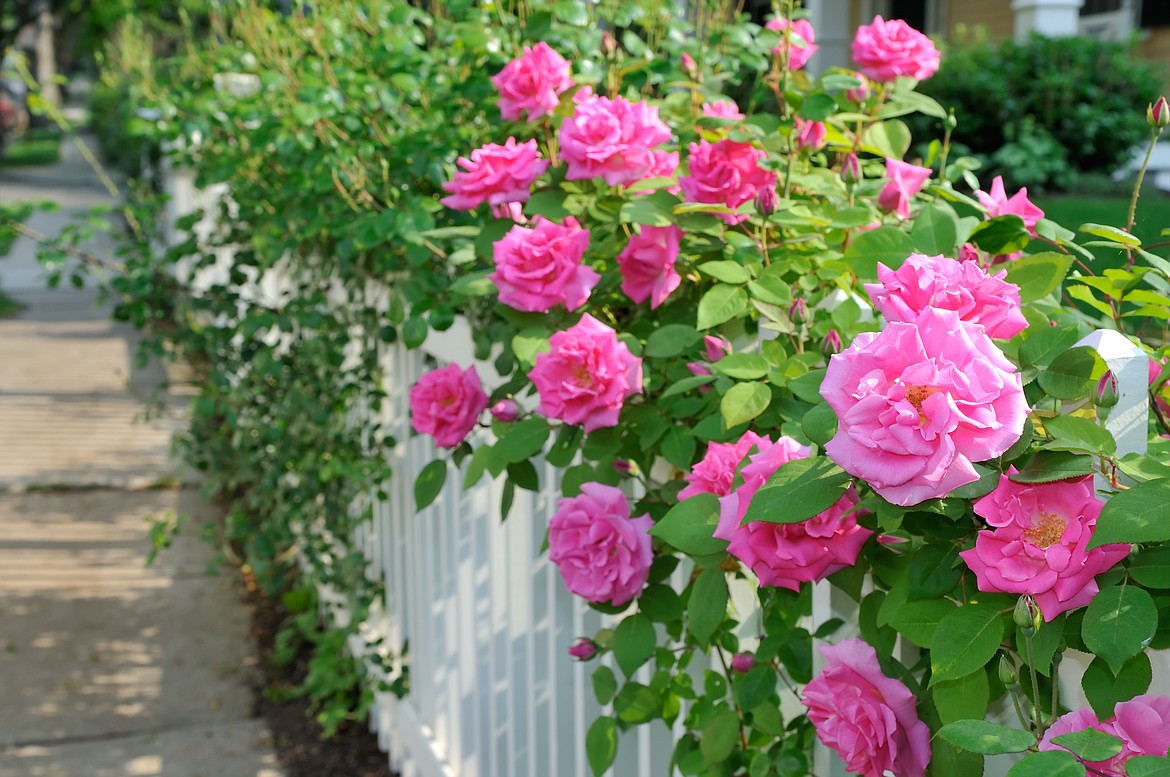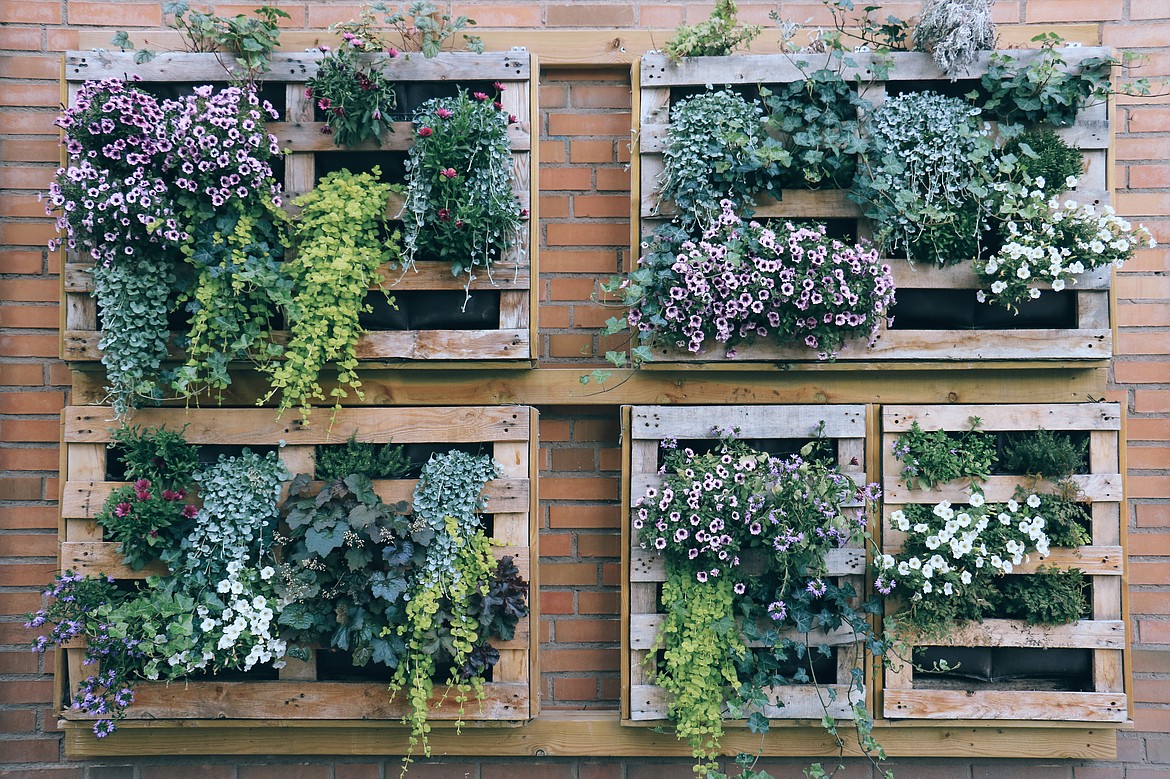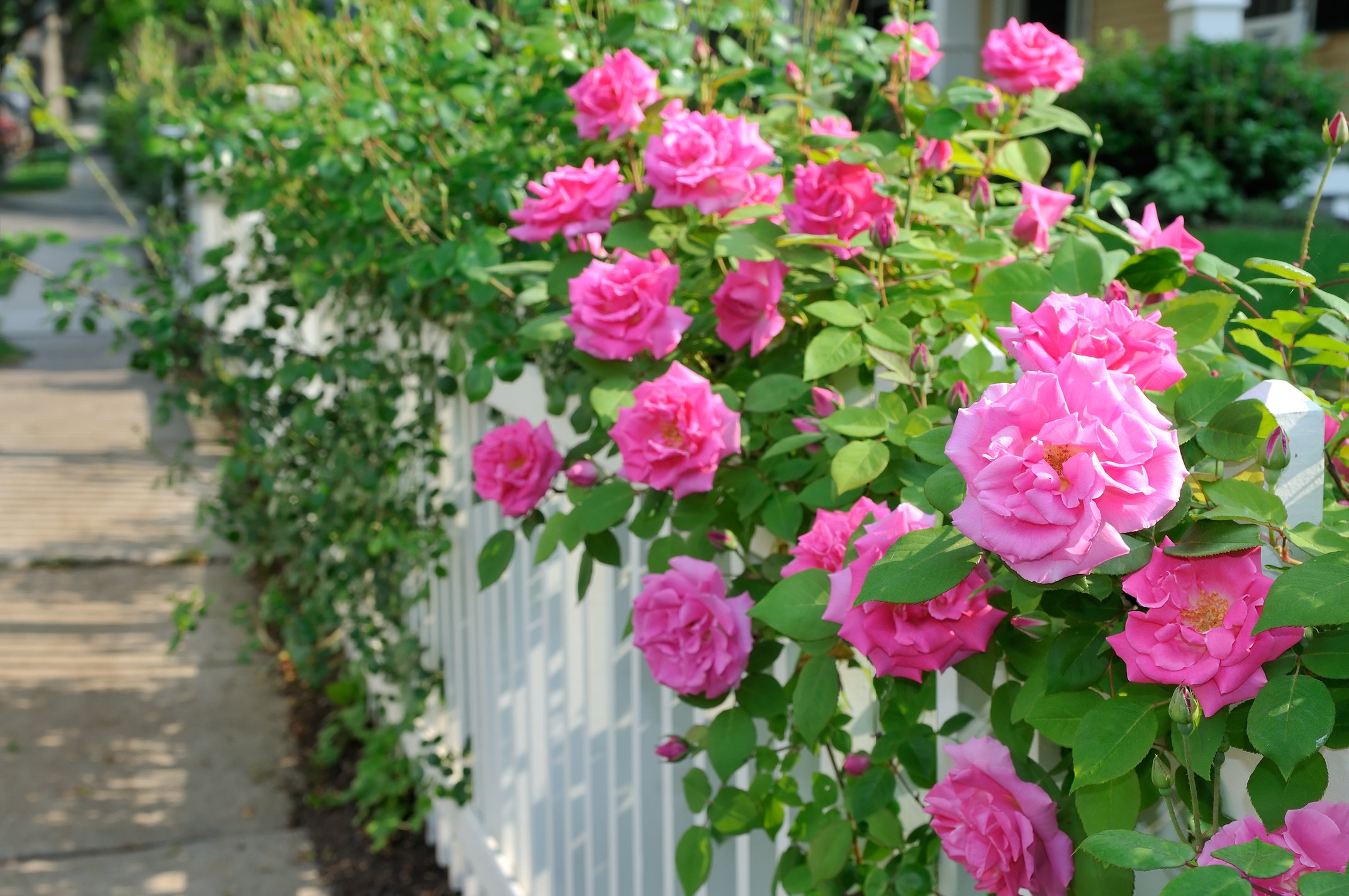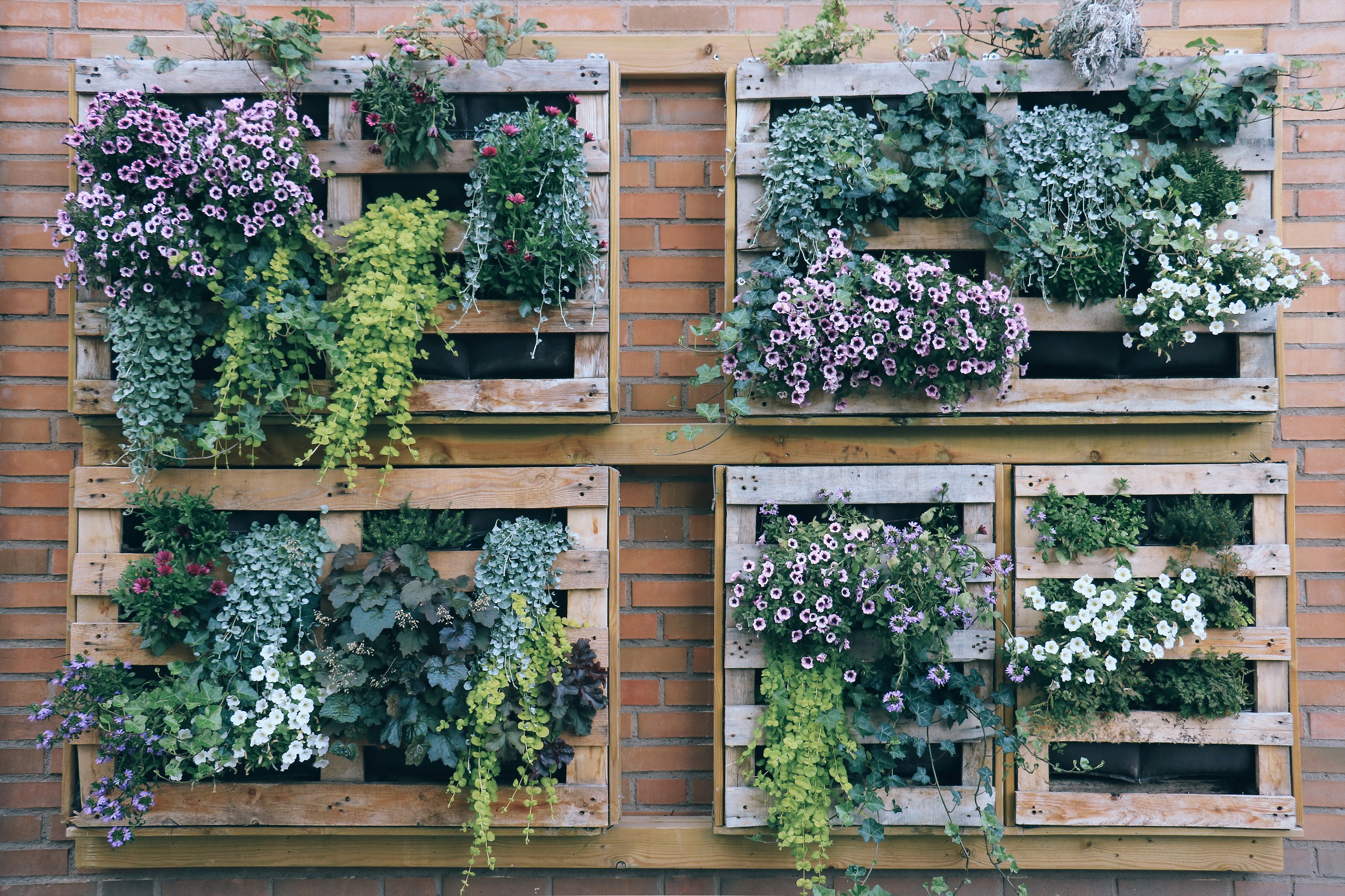Cramped for garden space? Go vertical instead
Sometimes we find ourselves with a minimum of space for planting "pretty" things. Perhaps all the available garden area is given to practical considerations — vegetables most likely, or maybe large perennial shrubs such as mature lilacs, hydrangeas, rhododendrons, or specimen roses that need space to themselves.
Don't give up on beauty. Surely somewhere you have a vertical site — a house, shed, or garage wall, for instance — or a fence at the property line. If you have walls, attach a lattice, perhaps a 4-foot by 8-foot sheet, leaving 3 to 4 inches of space between the wall and lattice for air and growing space. Make sure the growing bed is not at the drip line from the eaves, however.
Maybe you have room at the end of the garden or the median of your driveway for a lattice construct (don't spend hundreds of dollars on an arbor, just tack one or two attractive lattice sheets to upright posts or poles), which gives you 8 full feet of growing space that's only 18 inches to 2 feet in depth.
The ideal site, of course, would be a rock or stone wall on your property; a mini "cliff" covered with clinging vines is a beautiful focal point — as are all of the previous suggestions.
OK, you've found your site. What to plant? The list is almost endless. Flowering plants include climbing roses, clematis, honeysuckle, perennial peas, and (perhaps) hardy wisteria. We'll explore these one by one.
Roses: Climbers/ramblers are generally hardy. Consider the Don Juan, a fragrant, rich red plant that presents its flowers as "bouquets." Golden Showers has proven itself over some 40 years as an all-season bloomer with butter-yellow "tea rose"-looking buds and blooms that are sweetly fragrant. High Hopes is a true-pink beauty that smells like fresh strawberries and discards its own spent blooms for a very tidy plant. Cecile Brunner has been around since 1894, a true "old rose" who has proven her hardiness — she's sweetly scented and a vigorous climber.
All of these and other climbing roses need to be properly planted in rich soil with plenty of root room. Once established, they'll be carefree, only asking for a yearly springtime drink of fish emulsion and winter mulching against freezes. Asking at area nurseries for their suggestions for hardy climbers.
Clematis: Nearly all clematis are hardy in our zones 3 and 4, with a few needing the extra warmth of Zone 5, which is found in several local sites, notably Hope. The only standby, of course, is C. "Jackmanil," the dark blue classic that's dependable almost everywhere. C. "Nelly Moser" is another hardy bloomer, with huge light and dark pink bi-colored petals. C. "Star of India" is a fuchsia-to-purple flowered beauty that needs light pruning each spring. C. "Henryii" is a profuse summer bloomer whose pure white, golden-stamened blossoms return in the fall for a period of reprise.
My personal favorites are the "wild"-looking, smaller-flowered varieties. C. "Durandii," whose deep indigo blooms are also great when allowed to ramble over the landscape; C. "Golden Harvest," which looks like our own native Clematis except that it's a sunny yellow instead of periwinkle blue and provides silky, billowy seedheads for fall interest; and Sweet Autumn Cletamtis (C. paniculata), which will need a sunny spot but is generally hardy, sweetly fragrant (rare in Clematis) and with lovely, draping garlands of white, four-petaled blossoms. It, too, throws fluffy white seedpods for visual autumn interest.
All Clematis prefer sun, but not on their "feet." Their root base needs protection with ground cover or even a decorative rock placed to keep the sun from the bottom stems. If you select a clematis, find out if it's the kind that needs spring pruning. Some do not, and you wipe out your flowering canes without realizing it. (Later in the season, I'll write a reminder on the types of Clematis.)
There are several varieties of the honeysuckle (Lonicera) family, most of which are hardy for this region. Ask at local nurseries or check out your flower catalogs for colors you like best, making sure that the zone reflects your site. L. "Sertina" is a beautiful possibility, with early autumn red-and-white blooms that feed bees and hummingbirds when other blossoms are starting to fade. Its sweetly scented flowers are followed by bright red berries for winter interest and bird forage. It might be a bit late for the true Zone 3 and Zone 4 sites, but there are many others to choose from.
Perennial pea (Lathyrus latifolius) is akin to the sweat pea but without the fragrance or color variety. It ranges in color from a pretty, dark pink to fuchsia and is terrifically hardy to the point of being invasive. However, if you need a pretty and dependable filler for a wall or rock face, it's a winner, climbing or scrambling over the landscape with abandon. You can find it in almost every garden catalog.
Wisteria (Wisteria sinensis) is so lovely and fragile-looking that, unfortunately, in our climate, often succumbs to that look. There are, however, some hardy varieties that will grow and bloom here. Rather than ordering from afar, I recommend that you visit our excellent greenhouses and nurseries and talk to the owners and managers about the wisteria that are hardy here. Follow their instructions for planting and care, and you'll be rewarded with one of the most beautiful sights in flowerdom. (The Golden Chair tree is gorgeous and hardy here, but it's a tree, so not apropos for this column.)
Non-flowering vines are winners, too — though "non-flowering" is sort of a misnomer for the berries of the Virginia creeper (Parthenocissus inserta), and the hops of the hop vines (Humulus lupulus) are their "blooms." Both of these are hardy and beautiful, with the added bonus of glorious fall color in the Virginia creeper and a hop harvest with the hops, so talk with an expert at one of the area greenhouses and nurseries to find what you are looking for. There's an active hop operation in the Bonners Ferry area, so perhaps a nursery in that area could give sound advice. The neat thing about hops is that they die back to the ground in the winter, reemerging in the spring, so you can use the old vines for wreath-making and ornamental projects. (Do not, however, remove Virginia creeper vines because they grow from the old vines each year.)
There are lots of other climbers to consider, including many annuals such as sweet peas, nasturtiums, and even the double-duty scarlet runner bean. But one last option remains to be explored. We're talking about vertical gardening here, but isn't vertical up and down? In the happy chance that your site allows for planting at the top of your lattice as well as the bottom — a rocky wall, for example — you can plant wonderful things to drape down and meet the beauties coming up.
Creeping thyme (Thymus) has many varieties, including "Mother of Thyme" and others that can be planted at the top for draping gracefully over your lattice. For a heavier possibility, consider some of the Junipers (Juniperus), particularly Procumbens — a lavish hanger or draper — and, to me, the prettiest Juniper there is.
Some traditional groundcovers are also an option for draping; Vinca minor, with its perennial glossy leaves and periwinkle flowers, is a natural for such duty. Phlox sublata, that pretty and prolific creeper, is another consideration. Or give thought to planting one of the rambling roses at the top, to crawl down and mingle with the clematis growing up for a meeting of pure beauty.
There are, as you see, no excuses for not having a flower feature in your gardens. When there's no ground space, why not simply plant up?
Editor's note: For many years, Valle Novak wrote gardening and cooking columns for the Daily Bee. "Weekend Gardener" and "Country Chef" became renowned for their humor, information, and common-sense advice on how to do everything from planting to cooking. She left behind many columns to delight her many fans. This is one such column, originally published on March 11, 2001.







